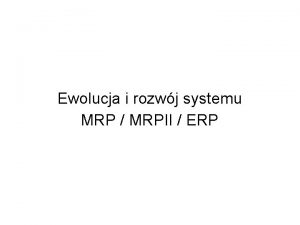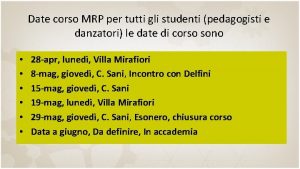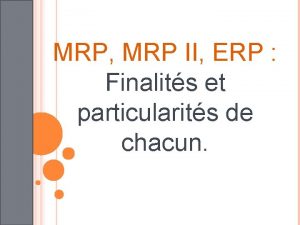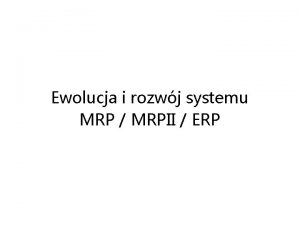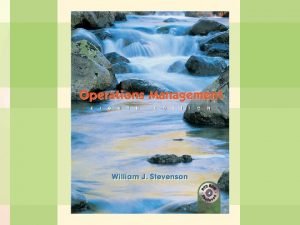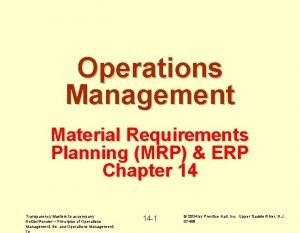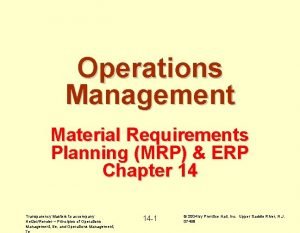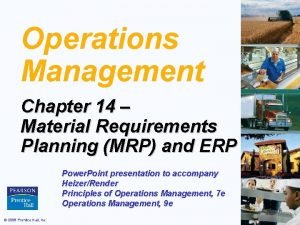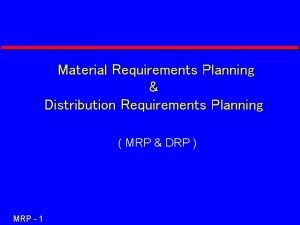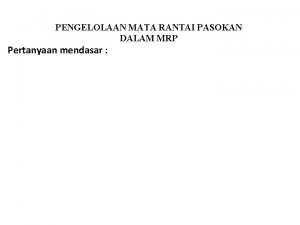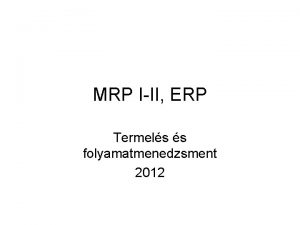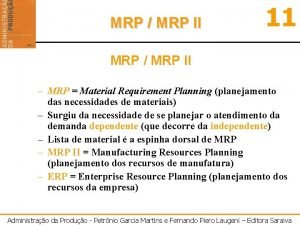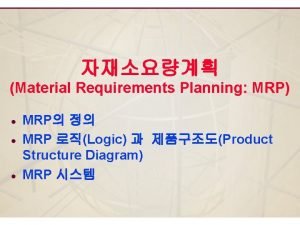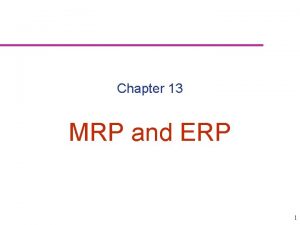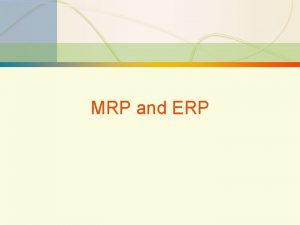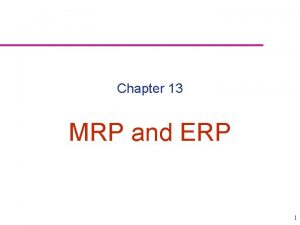Evolution and Development of MRP MRPII ERP Systems










- Slides: 10

Evolution and Development of MRP / MRPII / ERP Systems

MRP – Material Requirements Planning The basic module of the system MPS - Master Production Scheduling DEM Material resources BOM - Bill of Materials Product structure Forcasts INV MPS Orders - Inventory Transaction Inventory status PUR - Purchasing Control BOM MRP INV PUR SFC - Shop Flow Control Production Activity Control

CL MRP – Closed Loop Material Requirements Planning DEM Production planning Forcasts SOP Orders MPS BOM MRP Capacity planning CRP - Capacity Requirements Planning I/OC - Input/Output Control Load of Work Centers CRP SOP - Sales and Operations Planning INV PUR SFC I/OC

MRP II – Manufacturing Resource Planning Marketing resources Finance resources DEM Production planning Capacity planning Forcasts SOP RRP Orders MPS RCCP Interface with marketing area (distribution resources) and finance area DEM - Demand Management BOM MRP CRP INV RCCP- Rough Cut Capacity Planning RRP - Resource Requirements PUR SFC I/OC Planning

MANUFACTURING RESOURCES PLANNING SYSTEM MRP II

MRP II Standard System APICS 1989 SOP - (Sales and Operations Planning) DEM - (Demand Management) MPS MRP BOM INV SRS SFC CRP I/OC PUR DRP TPC FPI SYM PMT - (Master Production Scheduling) (Material Requirements Planning) (Bill of Material Subsystem) (Inventory Transaction Subsystem) (Scheduled Receipts Subsystem) (Shop Floor Control, Production Activity Control) (Capacity Requirements Planning) (Input/Output Control) (Purchasing) (Distribution Requirements Planning) (Tooling Planning and Control) (Financial Planning Interfaces) (Simulation) (Performance Measurement)

ERP (MRP III) Enterprise Resource Planning Marketing resources Finance resources DEM Production planning Capacity planning Forcasts SOP RRP MPS Orders BOM u Integration of all functions in enterprise u Total Enterprise Resources Management (Inter Functional Management ) u Integrated Organization RCCP MRP CRP INV PUR TOTAL MANAGEMENT INTEGRATION SFC I/OC

Benefits of MRPII/ERP system implementation in an organisation • • Reduced Inventory with fewer (none) shortages Improved Customer Service Improved Direct Labour Productivity Reduced Purchasing Cost Reduced Obsolescence Reduced Overtime Plan for future capacity needs

Development of MRP system 1960 1970 1980 1990 Production management integration Enterprise management integration Supply chain management integration MRP - Material Requirements Planning CL MRP - Closed Loop Material Requirements Planning MRP II - Manufacturing Resource Planning ERP - Enterprise Resource Planning DRP - Distribution Requirements Planning LRP - Logistics Requirements Planning DRP II - Distribution Resource Planning LIS - Logistics Information. System 2000

Wymogi efektywnego wdrożenia i funkcjonowania zintegrowanego systemu zarządzania klasy MRPII/ERP Dokładność, bezbłędność, aktualność i niezawodność danych: • Kartoteka strukturalna - 99% • Kartoteka rodzajowa - 99% • Kartoteka procesów technologicznych - 95% • Kartoteka stanowisk roboczych - 95% Rygor i dyscyplina w kontroli przepływu materiałów: • Zapasy - 99% • Zlecenia produkcyjne - 99% • Zlecenia nabycia - 99% • Zamówienia klientów - 99% Realny, wykonalny ze względu na zdolności produkcyjne Główny Plan Produkcji Szkolenia pracowników: • • 80% przeszkolonej i poinformowanej załogi Kierownik projektu wdrożenia systemu MRPII Zaangażowanie kierownictwa oraz jego uczestnictwo i zrozumienie: • Arbitraż w kwestiach spornych między – – – Marketingiem Produkcją Finansami System MRPII/ERP jest bezużyteczny jeżeli nie przestrzega się wysokiej dyscypliny w zarządzaniu zapasami Kontrola zapasów według klasyfikacji ABC: • Codzienna kontrola – klasa A pozycje rodzajowe o dużej wartości na wyjściu • Comiesięczna kontrola – klasa C pozycje o małej wartości na wyjściu
